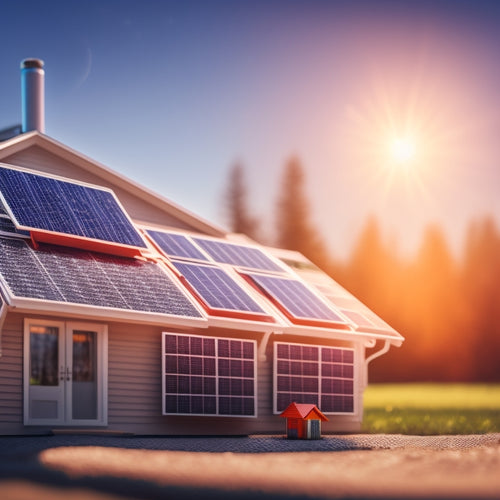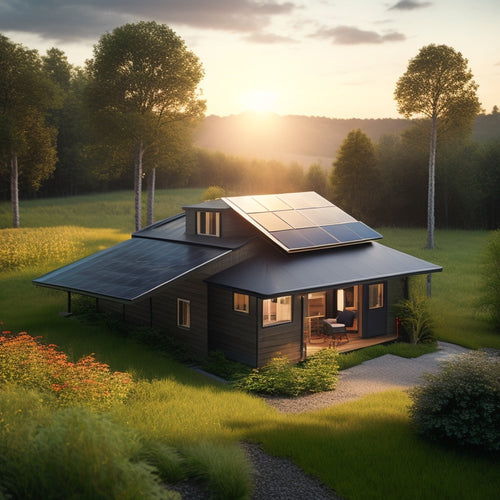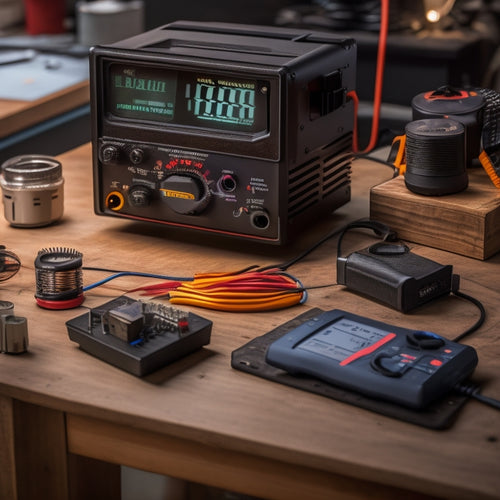
Safe Solar Panel Installation Practices
Share
When installing solar panels, you must guarantee structural integrity by evaluating load capacity, inspecting roof materials, and verifying compliance with local building codes. Inspect the site before installation to identify obstacles, potential fire hazards, and water damage. Wear protective gear, avoid electrical shock risks, and follow manufacturer guidelines to secure panels properly. Monitor weather conditions to avoid installations during peak hurricane seasons or extreme weather. By following these safe solar panel installation practices, you'll be well on your way to a successful and secure installation, and with a deeper understanding of the intricacies involved, you'll be better equipped to tackle the subtleties of this complex process.
Key Takeaways
- Ensure structural integrity by assessing load capacity, inspecting roof material, and verifying compliance with local building codes and regulations.
- Wear protective gear, including hard hats, safety glasses, gloves, and steel-toed boots, to prevent injuries and maintain focus.
- Conduct risk assessments to identify potential electrical hazards, de-energize circuits, and implement lockout/tagout procedures to prevent electrical shock.
- Follow manufacturer guidelines for safe installation procedures, proper handling, mounting, and electrical connections to maintain system warranty.
- Monitor weather conditions, avoiding installations during peak hurricane seasons, heavy rain, high winds, and extreme temperatures to ensure safety and efficiency.
Ensure Structural Integrity
Guarantee Structural Integrity
Most solar panel installations require anchoring to a roof or a ground-mounted structure, which demands a thorough assessment of the site's structural integrity.
You must evaluate the load capacity of the roof materials to guarantee they can support the weight of the solar panels, mounting hardware, and any additional components. This involves inspecting the roof's material, age, and condition, as well as checking for any signs of wear or damage.
Conduct thorough structural inspections structural capacity to identify weaknesses and understand roof strengths and weaknesses for informed installation decisions.
You should also verify that the roof's structure can withstand environmental factors like wind, snow, and seismic activity.
Wear Protective Gear Always
When handling solar panels and electrical components, you're exposed to various hazards, including electrical shock, cuts, and falls. To minimize these risks, it is vital to wear protective gear always. This gear not only protects you from physical harm but also guarantees you're mentally focused on the task at hand.
| Protective Gear Types | Purpose |
|---|---|
| Hard hats and safety glasses | Protect against falling objects and debris |
| Gloves and steel-toed boots | Prevent cuts and crushing injuries |
| Respirators and fall protection gear | Safeguard against hazardous materials and falls from heights |
Avoid Electrical Shock Risks
When installing solar panels, you must prioritize risk assessment to identify potential electrical shock hazards.
It's essential to take into account the efficiency ratings of your solar panels, making certain they're above 20% to minimize energy losses high-efficiency solar panels.
You'll need to guarantee a safe work environment by de-energizing circuits and locking out equipment to prevent accidental start-up.
Risk Assessment Priorities
Three vital risk assessment priorities stand out when it comes to avoiding electrical shock risks during solar panel installation: identifying potential electrical hazards, understanding the electrical circuit, and implementing appropriate safety measures.
You must identify potential electrical hazards, such as exposed wiring, damaged cables, or malfunctioning components. Understanding the electrical circuit is essential to recognize how the solar panels interact with the electrical system.
This knowledge enables you to implement appropriate safety measures, such as lockout/tagout procedures, to prevent electrical shock. By prioritizing hazard identification and risk mitigation, you can considerably reduce the risk of electrical shock and guarantee a safe installation process.
Ensure Safe Work Environment
You've identified potential electrical hazards and understood the electrical circuit, now it's time to secure a safe work environment that prevents electrical shock risks. A clean and organized site is vital in reducing electrical shock risks. Confirm site cleanliness by removing any debris, obstacles, or tripping hazards that can distract you or obstruct your work. Proper tool management is also important. Keep your tools in good condition, and verify they are stored safely when not in use.
| Safety Measures | Description |
|---|---|
| Site Cleanliness | Remove debris, obstacles, and tripping hazards |
| Tool Management | Keep tools in good condition and store them safely |
| Electrical Isolation | Isolate electrical circuits before starting work |
| Personal Protective Equipment | Wear appropriate PPE, such as insulating gloves and safety glasses |
Prevent Accidental Contact
Electrical shock risks remain a significant threat even with a clean and organized site. To prevent accidental contact, you must be aware of the electrical circuits and voltage levels present during installation.
Make certain you understand the grounding techniques specific to your equipment and follow them carefully. Verify the voltage of each circuit before making connections to avoid electrical shock.
You should also identify and label all electrical sources, including DC and AC power. Keep your workspace tidy, and avoid overreaching or stretching, which can increase the risk of accidental contact.
Follow Manufacturer Guidelines
When installing solar panels, it's vital to follow the manufacturer's guidelines to guarantee a safe and efficient installation. You'll find these guidelines in the manufacturer specifications and installation manuals provided with the solar panel system.
These resources outline the recommended installation procedures, including the proper handling and mounting of the panels, electrical connections, and grounding requirements. Securing the system's reliability and energy autonomy is critical, as highlighted in the key features of off-grid solar battery charging systems, which focus on charging efficiency, compatibility, and safety features.
By following these guidelines, you'll make certain that your solar panel system operates within the manufacturer's specified parameters, minimizing the risk of electrical shock, fire hazards, and system malfunction.
Additionally, adhering to the manufacturer's guidelines will help you maintain the system's warranty and guarantee compliance with local building codes and regulations.
Inspect Site Before Installation
Your installation site's existing conditions can greatly impact the safety and performance of your solar panel system. Before you begin, it's crucial to inspect the site to identify potential issues. This involves evaluating the site layout, taking note of any obstacles or shading that could affect sunlight exposure.
-
Check for overhead obstructions like power lines, tree branches, or roof vents that could interfere with panel installation or maintenance.
-
Verify the roof's structural integrity and confirm it can support the weight of the solar panels.
-
Identify any potential fire hazards, such as dry leaves or debris, that could compromise the system's safety.
- Look for signs of water damage or leaks that could affect the system's performance or longevity.
Secure Panels Properly
When securing solar panels, you'll need to choose the right mounting option for your installation, whether it's a roof-mounted, ground-mounted, or tracking system.
You'll also need to select anchor points that can withstand various environmental conditions and ascertain the system's structural integrity.
Panel Mounting Options
Mounting solar panels securely is a critical aspect of a safe and efficient installation.
You'll need to choose a suitable mounting system that meets local building codes and regulations.
Consider the following panel mounting options:
-
Roof-mounted systems: ideal for residential installations, these systems attach directly to your roof.
-
Ground-mounted systems: suitable for larger installations, these systems are freestanding and can be adjusted to optimize installation angles.
-
Tracking systems: designed to maximize energy output, these systems adjust to follow the sun's movement.
- Ballasted systems: a non-penetrating option that uses weights to secure the panels to the roof.
When selecting a mounting system, consider factors such as wind load, snow load, and roof type to guarantee a secure and efficient installation.
Anchor Point Selection
Selecting the right anchor points is essential to secure solar panels properly, as it directly affects the entire system's stability and efficiency.
When choosing anchor points, you'll need to take into account the load distribution on your solar panel system. This includes wind, snow, and weight loads, which can vary depending on your location and installation type.
You'll want to select anchor types that can handle these loads and guarantee your panels remain securely fastened. For example, stainless steel or aluminum anchors are suitable for most installations, while specialized anchors may be required for high-wind or high-snow areas.
Proper anchor point selection is critical to prevent panel damage, system failure, or even roof collapse. By choosing the right anchors, you'll assure a safe and efficient solar panel installation.
Tightening Sequence Matters
Securely fastening solar panels to the roof involves more than just tightening a few bolts; it requires a deliberate tightening sequence to confirm the entire system remains stable and efficient.
You'll need to verify that all bolts and screws are tightened in a specific order to maintain panel alignment and prevent damage to the roofing material.
To get it right, follow this sequence:
-
Start by tightening the middle bolts, working your way outward in a star pattern to prevent warping the panel frame.
-
Next, tighten the screws that secure the panel to the roof anchors, making sure to apply the recommended installation torque.
-
Then, tighten the remaining bolts and screws in a consistent pattern to maintain even pressure.
- Finally, double-check all connections to verify they're secure and meet the manufacturer's specifications.
Monitor Weather Conditions
You're about to start installing solar panels, but first, take a moment to check the weather forecast. Inclement weather can hinder your installation process and even pose safety risks. Weather forecasting is vital to guarantee a smooth and safe installation. Consider seasonal considerations, such as avoiding installations during peak hurricane seasons or extreme weather conditions.
| Weather Condition | Installation Suitability | Safety Concerns |
|---|---|---|
| Heavy Rain | Not Recommended | Risk of electrical shock, slippery surfaces |
| High Winds | Not Recommended | Risk of panel damage, installation difficulty |
| Extreme Heat | Recommended with Caution | Risk of heat stroke, sun exposure |
| Foggy Conditions | Recommended with Caution | Risk of reduced visibility, installation accuracy |
| Clear Skies | Recommended | Ideal installation conditions |
Frequently Asked Questions
Can I Install Solar Panels on a Metal Roof?
You can install solar panels on a metal roof, leveraging its benefits like durability and weather-tightness, but consider factors like roof material, thickness, and existing fasteners to guarantee a secure and watertight installation.
How Often Should I Clean My Solar Panels?
You should clean your solar panels every 6-12 months, depending on local pollution and debris levels, as part of regular solar panel maintenance to guarantee peak energy output, following a cleaning frequency that suits your environment's specific needs.
Do Solar Panels Work During Power Outages?
You'll find that solar panels don't provide power during outages unless you have a battery storage system, which can maintain solar efficiency even when the grid goes down, ensuring a reliable energy supply.
Can I Install Solar Panels Myself?
Venturing into the world of DIY installation, you'll soon realize it's not a walk in the park; without proper Safety precautions, you're playing with fire, so to speak - literally, considering electrical and rooftop hazards that can be deadly if not handled correctly.
How Long Do Solar Panels Typically Last?
You'll find that solar panels typically last around 25-30 years, with their efficiency degrading by about 0.5-1% annually, resulting in an overall solar panel lifespan that's both reliable and long-lasting, ensuring a significant return on your investment.
Related Posts
-

A Beginner's Guide to Navigating the Solar Investment Tax Credit
You're eligible to claim a significant Solar Investment Tax Credit (ITC) of 30% of total installation costs, but mane...
-

Diy Off Grid Solar
By embracing DIY off-grid solar, you can break free from grid dependence, slashing your energy bills by up to 90% and...
-

Key Features of a DC to AC Converter
A DC to AC converter features high efficiency and conversion rates, which reduce energy costs and improve performance...


